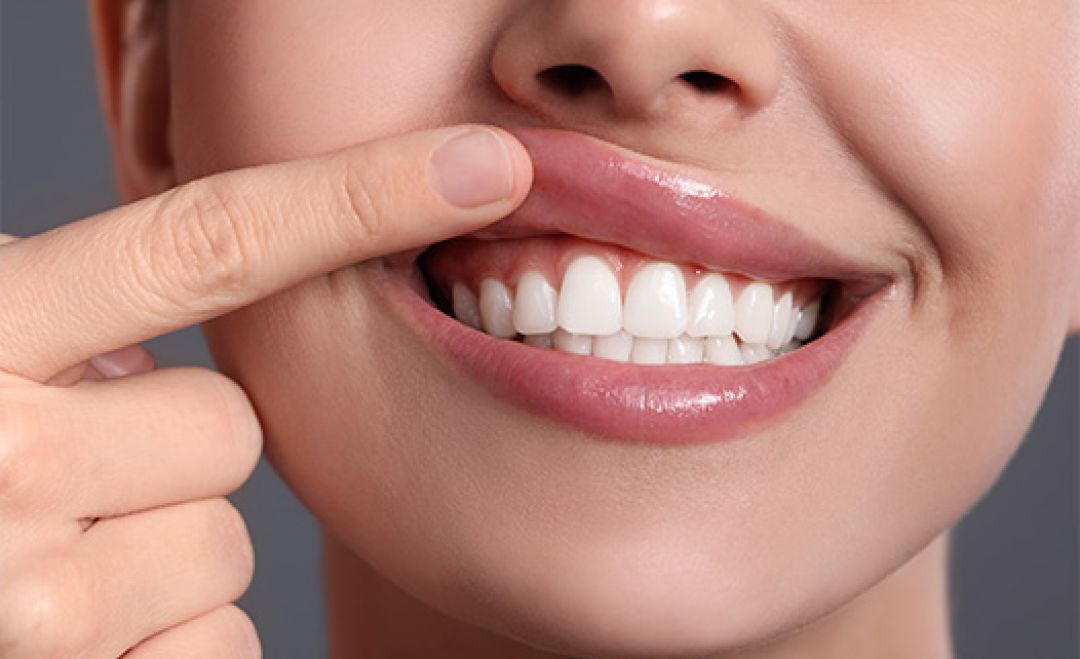Gum Contouring
Avarage Time Needed
Anesthesia Type
Average Session Required
Recovery Time

Online Consultation
What is Gum Contouring?
Gum contouring is a dental procedure that reshapes or removes parts of the gum line to improve your smile’s appearance. Sometimes, people have too much gum tissue, making their teeth look small or uneven. In other cases, the gum line may be too high or uneven. Gum contouring helps balance the ratio of gum to tooth, creating a more attractive smile.
During the procedure, a dentist or periodontist first numbs the area around your gums to keep you comfortable. They then use specialized tools, such as a laser or scalpel, to carefully remove or reshape extra tissue. If your gum line is too high, they may use grafting techniques to add tissue where it is needed. This ensures a balanced gum line and a more natural look.
One reason people choose gum contouring is to fix a “gummy smile,” where the gums show more than the teeth. This can make teeth appear shorter. By removing a small amount of gum tissue, more of each tooth becomes visible, providing a fuller smile. Additionally, the procedure can help even out crooked or lopsided gum lines.
Recovery is usually straightforward. Mild swelling or soreness is common for a few days, but over-the-counter pain relievers and a soft diet help manage discomfort. Maintaining good oral hygiene is crucial to prevent infection, so you should brush gently and possibly use a special mouth rinse. With proper care, gum contouring can lead to long-term results, giving you a balanced, confident smile.
How Is Gum Contouring Done?
Gum contouring is a procedure that carefully reshapes the gum line to create a more balanced and attractive smile. Dentists often recommend this treatment when someone has excess gum tissue that makes their teeth look small or uneven. Below is a general overview of how gum contouring is performed:
- Consultation and Examination: Your dentist first checks the health of your teeth and gums. They may take x-rays or use digital scans to understand the amount of gum tissue that needs adjusting. This step ensures you are a suitable candidate and helps plan the exact shape of your new gum line.
- Numbing the Area: On the day of the procedure, the dentist applies a local anesthetic to the gums. This numbs the area so you feel little to no discomfort. You stay awake, but the numbing keeps you comfortable throughout the process.
- Removing or Reshaping Gum Tissue: The dentist uses a laser or a scalpel to remove extra gum tissue. If your gum line is uneven, they will reshape it to match the contours of your teeth. Lasers help seal off blood vessels, often resulting in less bleeding and a faster recovery.
- Finishing Touches: Once the extra tissue is removed, the dentist may smooth and polish the edges to ensure a natural-looking result. If more tissue is needed in certain areas, a gum graft might be performed.
- Recovery and Aftercare: Many people experience mild swelling for a day or two. Over-the-counter pain relief and a soft diet can help ease any discomfort. Good oral hygiene practices, such as gentle brushing and saltwater rinses, support proper healing.
Who Needs Gum Contouring?
Gum contouring reshapes the gum line to create a balanced, attractive smile. This procedure is not for everyone, but it can be very helpful in certain situations. Below are the main groups of people who might benefit:
- Those with a Gummy Smile: When excessive gum tissue shows above the teeth, it can make teeth look short. Gum contouring removes some of this extra tissue so that more of each tooth is visible. This creates a more balanced and pleasing smile.
- People with Uneven Gum Lines: Some gum lines dip too low on one tooth and sit higher on another. This imbalance can cause an irregular-looking smile. Contouring smooths out the gum line, making it more uniform across all teeth.
- Individuals Seeking Cosmetic Improvements: If someone feels self-conscious about their gum line, they might opt for gum contouring. The procedure can boost confidence and result in a more harmonious dental appearance.
- Patients with Certain Medical Needs: In some cases, dentists recommend gum contouring for medical reasons. For instance, extra gum tissue can make it harder to clean around the teeth, increasing the risk of gum disease. Removing excess tissue can improve oral hygiene and reduce health risks.
- People Interested in Smile Makeovers: Gum contouring is often part of a bigger cosmetic plan. It can be combined with veneers, crowns, or teeth whitening to transform the entire smile.
What Are the Benefits of Gum Contouring?
Gum contouring offers numerous advantages, including:
- Improved Smile Aesthetics: Creates a balanced and harmonious gum line, enhancing overall smile appearance.
- Enhanced Oral Health: Removes excess gum tissue that can trap food particles, reducing the risk of cavities and gum disease.
- Boosted Confidence: A more attractive smile can significantly improve self-esteem and social interactions.
Additionally, gum contouring for receding gums not only improves appearance but also helps protect tooth roots and prevent further gum recession.
What Are the Risks or Side Effects of Gum Contouring?
While gum contouring is generally safe, potential risks and side effects include:
- Gum Sensitivity: Temporary sensitivity to hot and cold foods and beverages.
- Infection: Although rare, infections can occur if proper hygiene is not maintained post-procedure.
- Over-Contouring: Removing too much gum tissue can lead to an unnatural appearance or expose tooth roots.
Gum contouring gone wrong typically involves complications like excessive tissue removal or improper healing. Choosing a qualified professional and following post-procedure care guidelines can minimize these risks.
How to Prepare for a Gum Contouring Procedure?
Preparation for gum contouring involves several steps to ensure a successful outcome:
- Consultation: Schedule a consultation with a dental professional to discuss your goals and evaluate your oral health.
- Medical History: Provide a comprehensive medical history, including any medications or allergies.
- Oral Hygiene: Maintain excellent oral hygiene leading up to the procedure to reduce the risk of infection.
- Pre-Procedure Instructions: Follow any specific instructions provided by your dentist, such as fasting or avoiding certain medications.
How to Care for Your Gums After Contouring?
Post-procedure care is crucial for optimal healing and results. Follow these guidelines:
- Oral Hygiene: Gently brush and floss as advised by your dentist to keep the area clean.
- Avoid Irritants: Refrain from smoking, alcohol, and spicy foods that can irritate the gums.
- Medications: Take prescribed antibiotics or pain relievers to manage discomfort and prevent infection.
- Follow-Up Appointments: Attend all scheduled follow-ups to monitor healing progress.
Gum contouring after care ensures that the gums heal properly and the results are long-lasting.
Is Gum Contouring Painful?
Gum contouring is typically not painful, thanks to effective anesthesia options. During the procedure, local anesthesia numbs the treatment area, minimizing discomfort. Post-procedure, some patients may experience mild soreness or swelling, which can be managed with over-the-counter pain relievers.
Does gum contouring hurt? Most patients report minimal pain, especially with laser gum contouring, which tends to be less invasive and causes less post-operative discomfort.
How Much Does Gum Contouring Cost?
Gum contouring costs vary depending on several factors, such as the extent of the procedure, the dentist’s expertise, and the type of tools used. On average, a single tooth can range from $50 to $350 for contouring. However, if multiple teeth require reshaping, the total price can go much higher, potentially reaching $1,000 to $3,000 or more for a full smile makeover. The location of the dental office also influences the price. Clinics in major cities or upscale areas might charge more due to higher operating costs.
The method chosen impacts the final bill as well. Traditional contouring with a scalpel can sometimes be less expensive, but it may involve more bleeding and a slightly longer healing time. Laser contouring usually costs more, yet many find it worth the price due to faster healing and greater precision. Dentists with advanced training in cosmetic procedures often charge more for their skills and experience.
How Long Does Gum Contouring Take to Heal?
The healing timeline for gum contouring is relatively swift:
- Initial Healing: Most patients experience significant healing within one to two weeks.
- Full Recovery: Complete healing and stabilization of the gum tissue typically occur within four to six weeks.
Gum contouring healing time can vary based on the extent of the procedure and individual healing responses. Laser gum contouring healing tends to be faster due to the minimally invasive nature of laser treatments.
Can Gum Contouring Fix a Gummy Smile?
Yes, gum contouring is highly effective in correcting a gummy smile. By removing excess gum tissue, the procedure reduces the amount of gum exposed when smiling, resulting in a more balanced and aesthetically pleasing appearance. Gummy smile surgery celebrity gum contouring showcases how the procedure can transform smiles, making it a popular choice among those seeking to enhance their facial aesthetics.
Are There Non-Surgical Alternatives to Gum Contouring?
For individuals seeking alternatives to surgical gum contouring, several non-invasive options are available:
- Botox for Gummy Smiles: Botox injections can relax the upper lip muscles, reducing gum exposure during smiling. This is a temporary solution that typically lasts three to six months.
- Orthodontics: Braces or aligners can reposition teeth and adjust the bite, indirectly affecting the gum line and smile aesthetics.
- Veneers and Bonding: Cosmetic dental treatments can improve the appearance of teeth and gums without altering the gum tissue itself.
These alternatives may be suitable for specific cases, but gum contouring vs crown lengthening often depends on the underlying cause of the gummy smile and desired outcomes.
What’s the Difference Between Gum Contouring and Crown Lengthening?
While both procedures aim to enhance smile aesthetics, gum contouring and crown lengthening serve different purposes:
- Gum Contouring: Primarily focuses on reshaping the gum line to achieve a balanced and even appearance. It addresses issues like gummy smiles and uneven gums.
- Crown Lengthening: Involves removing gum tissue and sometimes bone to expose more of the tooth structure. This procedure is often necessary for restorative dental work, such as crowns, bridges, or veneers.
- Crown Lengthening vs Gum Contouring: Crown lengthening is more invasive and typically performed for functional dental reasons, whereas gum contouring is mainly cosmetic.
Who Performs Gum Contouring Procedures?
Gum contouring is performed by qualified dental professionals, including:
- Periodontists: Specialists in the treatment of gum diseases and the placement of dental implants, often performing complex gum contouring procedures.
- Cosmetic Dentists: Focused on enhancing the appearance of teeth and gums, cosmetic dentists frequently offer gum contouring as part of their services.
- Oral Surgeons: Experts in surgical procedures of the mouth and jaw, capable of performing both traditional and laser gum contouring.
Choosing a gum contouring specialist near me ensures that you receive expert care tailored to your specific needs.
Is Gum Contouring Covered by Insurance?
Gum contouring is generally considered a cosmetic procedure, which means it is typically not covered by dental insurance plans. However, exceptions may apply if the procedure is deemed medically necessary, such as treating severe gum recession or preparing for restorative dental work.
Insurance Implications
- Cosmetic Coverage: Most insurance plans exclude cosmetic procedures like gum contouring.
- Medical Necessity: If prescribed by a dental professional for health reasons, partial or full coverage may be possible.
It’s advisable to consult with your insurance provider and dental clinic to explore potential coverage options.
Gum contouring is a versatile and effective solution for enhancing smile aesthetics and improving oral health. Whether addressing a gummy smile, uneven gums, or receding gums, this procedure offers lasting benefits with minimal risks. By understanding the procedure, costs, and care involved, you can make an informed decision to achieve the smile you’ve always desired.
Online Consultation






